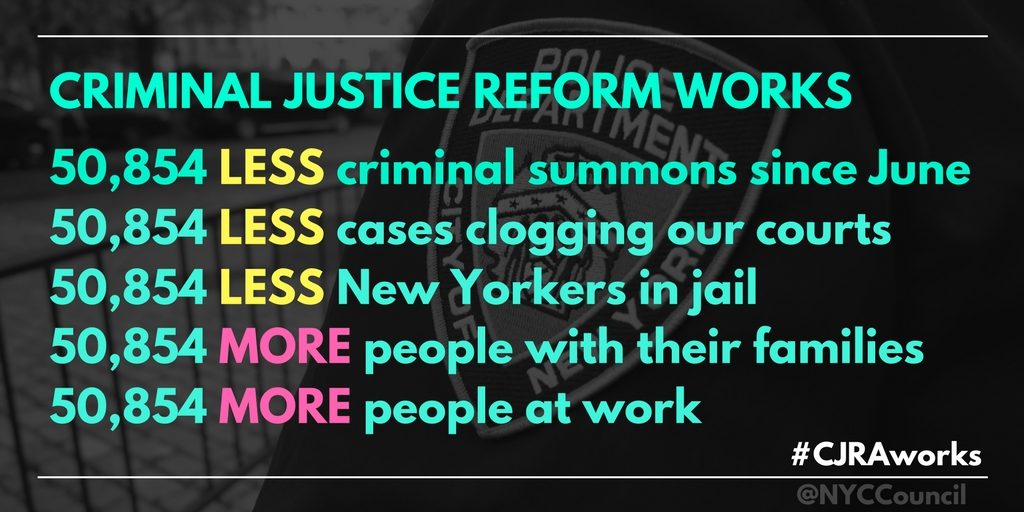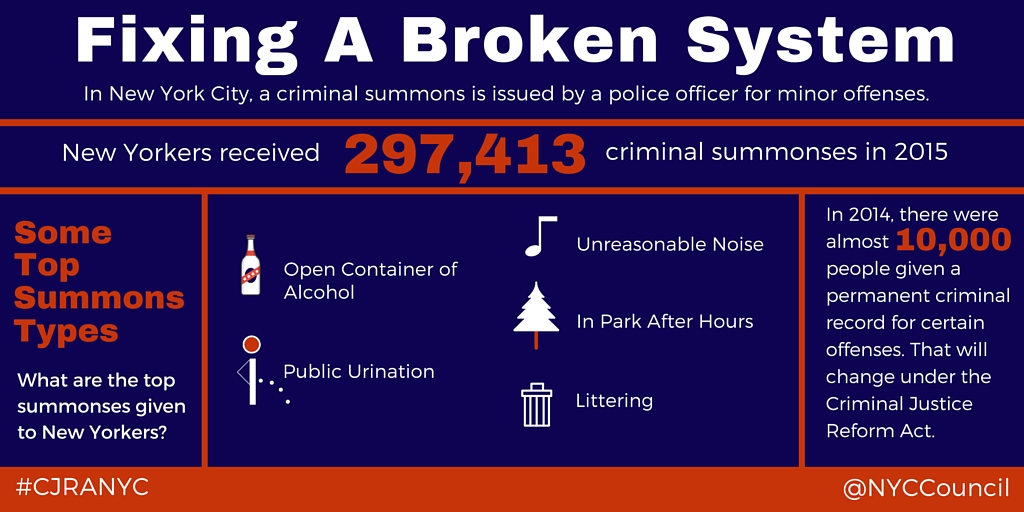Too many people were focused on an outdated and wrong policy of over-criminalizing small offenses – one that has clearly affected communities of color. Our City is safer than ever and the Council has lead the way with smart, progressive legislation that works.
Speaker Melissa Mark-Viverito
In May 2016, the Council passed historic legislation to create more proportional penalties for certain low-level, non-violent offenses. The Criminal Justice Reform Act (CJRA) was signed into law on June 13, 2016, and has now led to a 90 percent drop in criminal court summonses.
By reducing summonses issued, the City helps to prevent minor offenses from leading to arrests. Being arrested can have a severe impact on a person’s life, even if that person has had no prior interaction with the criminal justice system.
In August 2017, the Council also worked with four of the City’s District Attorney offices to clear the summons backlog for minor offenses like having an open container or entering a park after hours. This dismissed over 644,000 outstanding warrants.
Speaker Melissa Mark-Viverito called for this initiative in her 2017 State of the City address, and spent the next year and a half championing it, so that New Yorkers would no longer have unnecessary interactions with the criminal justice system.
Preliminary data shows that 50,854 less summonses were issued between June 13, and October 1, 2017, than the same period the year prior. Thousands of summonses were being issued annually for these offenses, which disproportionately impacted low-income people of color.
This reduction means that thousands of New Yorkers will never face the threat of unnecessary arrest for failure to appear in court for a low-level offense. This translates to less cases clogging up our overburdened court systems, more people at home caring for their families and not missing work or school, and less New Yorkers being sent to Rikers, which saves the City from unnecessary expenditures for non-violent offenses.

Criminal Summonses Issued 2007-Projected 2017
Source: NYPD Criminal Court Summons Reports 2007-June 30, 2017
Where will these cases be sent?
CJRA created new policies for officers to issue civil tickets in lieu of criminal summonses for these low-level offenses. Such tickets are adjudicated through the City’s administrative law court, the NYC Office of Trials and Hearings (OATH).
In addition to being more accessible, OATH allows respondents to:
- contest charges by phone or online
- choose to perform community service in lieu of a fine
- seek navigation and forms assistance at dedicated help centers
- come in person during extended evening and weekend hours
This creates expanded opportunities for respondents to be in compliance with New York City law, regardless of income, and work, school, or family obligations.
Which offenses are included?
In 2015, the NYPD issued over 150,000 criminal summonses for having an open container of alcohol, being in a park after hours, littering, public urination, and unreasonable noise. Some of these summonses gave offenders a permanent criminal record, and missing one court date led to an arrest warrant.
These penalties did not fit the crime. While the offenses remain illegal, the Council has passed a series of laws to solve this problem.
This new legislation sends over 100,000 of these cases to civil court rather than criminal court, saving almost 10,000 people per year from having a permanent criminal record and avoiding over 50,000 warrants every year. Many of the offenses below already had civil penalty options, which were not being issued by the NYPD.
The bills affect the following offenses:
- Open Container of Alcohol
- Parks Rules (being in Park after hours, walking on grass, disobeying signage)
- Littering
- Public Urination
- Unreasonable Noise

Why were people being arrested?
In 2015, New Yorkers received 297,413 criminal summonses for everything from having an open container of alcohol to breaking park rules. That meant that many people were required to take a day off work every year to go to court. And if someone missed their court date, they had an open warrant.
There are 1.5 million open summons warrants in New York. If you have an open warrant and get stopped by the police, you will be detained for approximately 24 hours waiting to go before a judge.
What were the results of these criminal summonses?
From 2003 to 2013, almost two thirds of cases were dismissed. Only 21% of people were found guilty, and the result was almost always a fine. Between 40% and 50% of people with summonses for offenses like open container and parks violations missed their court dates and ended up with an open warrant.
Results of Criminal Summonses 2003-2013
Who does this affect?
Many neighborhoods are impacted by criminal summonses, resulting in a significant number of people with criminal records. Some neighborhoods are impacted more than others.
Neighborhoods that have received the most criminal summonses per resident:
- Canarsie
- Brownsville
- Jamaica
- South Bronx
- East Harlem
- Mott Haven
- Port Morris
- Hunts Point
Residents in low-income neighborhoods have been more likely to receive criminal summonses. In 2015, the top summons in each of these neighborhoods was Open Container of Alcohol.
What is the difference between criminal and civil court summonses?
Criminal Court Summonses:
- A person may receive a permanent criminal record for some criminal summonses.
- A criminal summons requires a personal court appearance in almost all cases.
- A warrant will be issued if a person does not appear in criminal court. The warrant rate in criminal court for these offenses is between 40% and 50%, resulting in over 1.5 million active summons warrants in the City.
Civil Court Summonses:
- A person will not receive a permanent criminal record for civil summonses.
- Fines can be paid online and appearances can be made by phone.
- A warrant will not be issued if a person does not appear in civil court.
- The rate of fines being imposed in civil court is higher than criminal summons.
